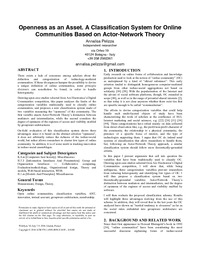Openness as an asseta classification system for online communities based on actor-network theory
Annalisa Pelizza
Publikationsdatum:
Zu finden in: WikiSym 2010, 2010
|
 |
 Diese Seite wurde seit 6 Jahren inhaltlich nicht mehr aktualisiert.
Unter Umständen ist sie nicht mehr aktuell.
Diese Seite wurde seit 6 Jahren inhaltlich nicht mehr aktualisiert.
Unter Umständen ist sie nicht mehr aktuell.
 Zusammenfassungen
Zusammenfassungen
There exists a lack of consensus among scholars about the definition and categorization of technology-mediated communities. If these divergences hamper the possibility to devise a unique definition of online communities, some principia divisionis can nonetheless be found, in order to handle heterogeneity.
Drawing upon case studies selected from Ars Electronica’s Digital Communities competition, this paper analyses the limits of the categorization variables traditionally used to classify online communities, and proposes a new classification system made of two variables measuring the “openness” of the community. The first variable enacts Actor-Network Theory’s distinction between mediators and intermediaries, while the second considers the degree of openness of the regimes of access and visibility enabled by groupware architectures.
On-field evaluation of this classification system shows three
advantages: since it is based on the abstract criterion “openness”, it does not arbitrarily reduce the richness of the techno-social world, but rather allows researchers to cluster few types of online community. In addition, it is of some merit in tracking innovation in techno-social assemblages.
Von Annalisa Pelizza im Konferenz-Band WikiSym 2010 im Text Openness as an asset (2010) Drawing upon case studies selected from Ars Electronica’s Digital Communities competition, this paper analyses the limits of the categorization variables traditionally used to classify online communities, and proposes a new classification system made of two variables measuring the “openness” of the community. The first variable enacts Actor-Network Theory’s distinction between mediators and intermediaries, while the second considers the degree of openness of the regimes of access and visibility enabled by groupware architectures.
On-field evaluation of this classification system shows three
advantages: since it is based on the abstract criterion “openness”, it does not arbitrarily reduce the richness of the techno-social world, but rather allows researchers to cluster few types of online community. In addition, it is of some merit in tracking innovation in techno-social assemblages.
 Dieses Konferenz-Paper erwähnt ...
Dieses Konferenz-Paper erwähnt ...
 Begriffe KB IB clear | Akteur-Netzwerk-Theorie (ANT)Actor-network theory
, CommunityCommunity
, GroupwareGroupware
,  Offenheit Offenheit openness
, Wikiwiki openness
, Wikiwiki
|
 Dieses Konferenz-Paper erwähnt vermutlich nicht ...
Dieses Konferenz-Paper erwähnt vermutlich nicht ... 
 Nicht erwähnte Begriffe | Wiki in education |
 Zitationsgraph (Beta-Test mit vis.js)
Zitationsgraph (Beta-Test mit vis.js)
 1 Erwähnungen
1 Erwähnungen 
- Der Wiki-Weg des Lernens - Gestalten und Begleiten von Lernprozessen mit digitalen Kollaborationswerkzeugen (Michele Notari, Beat Döbeli Honegger) (2013)



- 3. Lernen im Spannungsfeld von Öffentlichkeit, Öffnung und Offenheit - Überlegungen am Beispiel des Wikieinsatzes in Schulen (Sandra Hofhues, Katharina Uhl)


- 3. Lernen im Spannungsfeld von Öffentlichkeit, Öffnung und Offenheit - Überlegungen am Beispiel des Wikieinsatzes in Schulen (Sandra Hofhues, Katharina Uhl)
 Anderswo finden
Anderswo finden
 Volltext dieses Dokuments
Volltext dieses Dokuments
 |  Openness as an asset: Artikel als Volltext ( Openness as an asset: Artikel als Volltext ( : :  , 461 kByte; , 461 kByte;  : :  Link unterbrochen? Letzte Überprüfung: 2021-03-21 Letzte erfolgreiche Überprüfung: 2019-02-28) Link unterbrochen? Letzte Überprüfung: 2021-03-21 Letzte erfolgreiche Überprüfung: 2019-02-28) |
 Anderswo suchen
Anderswo suchen 
 Beat und dieses Konferenz-Paper
Beat und dieses Konferenz-Paper
Beat hat Dieses Konferenz-Paper während seiner Zeit am Institut für Medien und Schule (IMS) ins Biblionetz aufgenommen. Beat besitzt kein physisches, aber ein digitales Exemplar. Eine digitale Version ist auf dem Internet verfügbar (s.o.). Aufgrund der wenigen Einträge im Biblionetz scheint er es nicht wirklich gelesen zu haben. Es gibt bisher auch nur wenige Objekte im Biblionetz, die dieses Werk zitieren.










 Biblionetz-History
Biblionetz-History